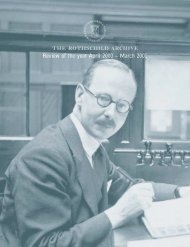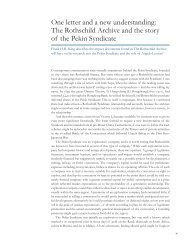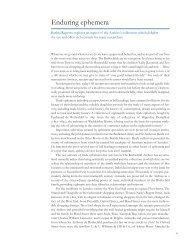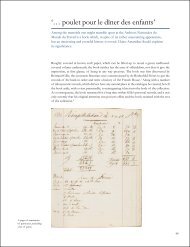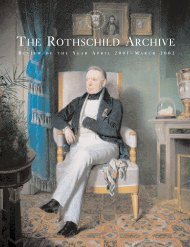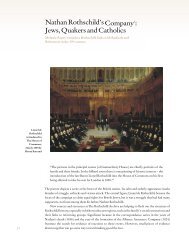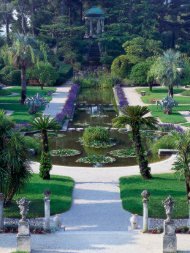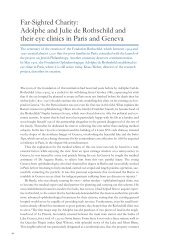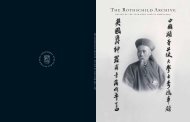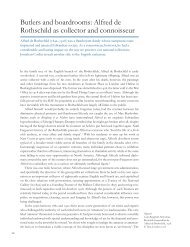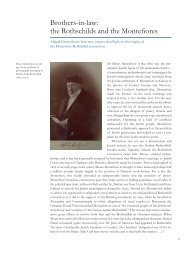66900 Rothschild Archive - The Rothschild Archive.
66900 Rothschild Archive - The Rothschild Archive.
66900 Rothschild Archive - The Rothschild Archive.
Create successful ePaper yourself
Turn your PDF publications into a flip-book with our unique Google optimized e-Paper software.
Even after the foundation of the Courtauld Institute in 1930 ‘art history’ continued to elicit<br />
widespread suspicion. Connoisseurship, high prices and popular appeal continued to define the<br />
sort of art that ‘belonged’ in a national collection. High art remained yoked to prestige and<br />
wealth, the museum continued to be seen as a marble palace. This, rather than circuses or<br />
Reynolds portraits was Alfred’s legacy to the nation. For him, the museum was just another<br />
stage. Here, as at Halton, he made the butlers and the pretty ladies dance.<br />
Jonathan Conlin has published a number of articles on eighteenth- and nineteenth-century British cultural<br />
history, and teaches British History at Southampton University. His first book, <strong>The</strong> Nation’s<br />
Mantelpiece: A History of the National Gallery, 1824–1974 (Pallas Athene) will appear in<br />
October 2006.<br />
notes<br />
1 Niall Ferguson, <strong>The</strong> World’s Banker: <strong>The</strong><br />
History of the House of <strong>Rothschild</strong> (London:<br />
Weidenfeld & Nicolson, 1998), p.744.<br />
2 Ibid., pp.744, 750–2, 758, 767–9, 873, 921.<br />
3 ral 000/40.<br />
4 Notes in Alfred’s Collector’s File in the<br />
Provenance Index at the Getty Research<br />
Institute, Malibu claim that these were in<br />
fact security for a loan. Receipts preserved<br />
in the <strong>Archive</strong> dated 1907 and 1911<br />
suggest that the paintings might have been<br />
security for a loan between Asher<br />
Wertheimer and the 5th Baron Ashburton<br />
(Francis Denzil Baring, 1866–1938),<br />
although much remains unclear. ral<br />
000/174b, ff.33, 40 and 54.<br />
5 Telegram of 28 February 1896. National<br />
Gallery <strong>Archive</strong> [hereafter nga], Board<br />
Minutes, 3 March 1896.<br />
6 Nicholas D. de <strong>Rothschild</strong>, ‘Alfred de<br />
<strong>Rothschild</strong> and the “R” Style’,<br />
(unpublished University of Cambridge<br />
BA <strong>The</strong>sis, 1973), <strong>Rothschild</strong> <strong>Archive</strong>,<br />
000/258. I am grateful to the author for<br />
kindly allowing me to consult this work,<br />
which I found most useful in preparing<br />
this piece.<br />
7 Alfred de <strong>Rothschild</strong> to C.H. Collins<br />
Baker, 22 June 1916. nga, ng26/101.<br />
8 See Report of Committee appointed by the<br />
Treasury to consider the housing of the collection of<br />
… the late Lady Wallace Cmnd. 8445 (1897),<br />
esp. q229 and q250. For the electroliers, see<br />
Wallace Collection <strong>Archive</strong>s [hereafter<br />
wca], Board Minutes, 1 May 1900. For<br />
reactions to gilding, see National <strong>Archive</strong>s<br />
of Scotland, gd510/1/45 and Glasgow<br />
University Library, MacColl Papers, s451.<br />
<strong>The</strong> Wallace Board Minutes show Alfred<br />
attending regularly, proposing ways of<br />
advertising the collection, introducing<br />
refreshment facilities and extending the<br />
hours.<br />
9 ‘I should doubly prize the little picture’,<br />
Alfred wrote, ‘as having belonged to a<br />
gentleman, who by his exquisite taste and<br />
unbounded popularity so well deserves to<br />
be the possessor of the finest collection of<br />
works of art in the world.’ Alfred de<br />
<strong>Rothschild</strong> to Sir Richard Wallace, 31<br />
March 1875. wca, ar2/251.<br />
10 Alfred left this work to the National<br />
Gallery at his death. One Director of the<br />
Gallery (Sir Charles Holmes) would later<br />
express disappointment that Alfred chose<br />
to leave the rest of his collection (along<br />
with the Halton Estate) to his nephew,<br />
Lionel Nathan de <strong>Rothschild</strong>, who sold<br />
most of it off. It was, he said, a cautionary<br />
tale against appointing millionaires as<br />
Trustees in the hope that they would make<br />
large bequests. But full-length Reynolds<br />
portraits were at the top of the market at<br />
the time. Seen in this light, the bequest<br />
hardly seems stingy. Holmes to Curzon, 21<br />
March 1921. British Library, Oriental and<br />
India Office Library, mss eur f112/58.<br />
11 A transcript of the book is available at <strong>The</strong><br />
<strong>Rothschild</strong> <strong>Archive</strong>.<br />
12 For the hens, see Mrs Lionel de<br />
<strong>Rothschild</strong>’s recollections, recorded in 1970<br />
as part of Nicholas de <strong>Rothschild</strong>’s<br />
researches into Alfred’s taste. ral 000/258.<br />
13 Ferguson, <strong>The</strong> World’s Banker, p.859.<br />
14 See William Gregory to Alfred de<br />
<strong>Rothschild</strong>, 24 June 1884. ral 000/182, f.1.<br />
15 nga, Trustee Minutes, 4 February 1896.<br />
Some credit should also go to a Treasury<br />
official, G.H. Murray, who clearly played an<br />
equally important role in framing the<br />
minute. See his memo of 30 March 1894.<br />
National Library of Scotland, Rosebery<br />
Papers, 10150, f.186.<br />
16 Although some officials were on Phillips’<br />
side, they did little to support him. See the<br />
correspondence of Phillips and Bernard<br />
Mallet in wca, ar50/d.<br />
17 See Carlisle to Gladstone, 19 February<br />
1894. National Library of Scotland,<br />
Rosebery Papers, 10150, f.110. <strong>The</strong> same<br />
volume contains many other letters on the<br />
issue from Burne Jones, Holman Hunt,<br />
Charles Fairfax Murray, Lord Leighton and<br />
others. See also Alan Bell, ‘Colvin vs.<br />
Poynter: the directorship of the National<br />
Gallery, 1892–4’, in Connoisseur (December<br />
1975), pp.278–83. While not opposed to<br />
Poynter, Alfred’s preferred candidate was<br />
Walter Armstrong, Director of the<br />
National Gallery of Ireland.<br />
18 For examples of Alfred’s opposition to<br />
specific pictures brought forward for<br />
consideration by Poynter see nga, Trustee<br />
Minutes, 10 December 1895 (over<br />
Parmigiano from Scarpa Collection,<br />
Milan), 14 April 1896 (over an ‘ugly’<br />
Bronzino) and 1 June 1897 (over Bettes’<br />
Portrait of a Man and Masolino Christ Among<br />
the Doctors). See Poynter to George<br />
Howard, 2 May 1896. Castle Howard,<br />
Papers of the 9th Earl of Carlisle, J22/57.<br />
For Holroyd’s reaction to similar<br />
resistance, see bl, Oriental and India<br />
Office Library, mss eur f112/57.<br />
19 nga, Trustee Minutes, 7 July 1909. Alfred<br />
clearly disagreed with the 1913 Curzon<br />
Reports findings. His initial refusal to sign<br />
the report made difficulties for Curzon. bl,<br />
Oriental and India Office Library, mss eur<br />
f112/62.<br />
20 Alfred de <strong>Rothschild</strong> to D’Abernon,<br />
5 November 1909. ral 000/182, f.23<br />
21 Alfred de <strong>Rothschild</strong>, printed memo, n.d.<br />
bl, Oriental and India Office Library, mss<br />
eur f112/64.<br />
22 George E. Ambrose served as Clerk from<br />
1878 to 1897 and Chief Clerk from<br />
1897–1914; Hawes Turner was Keeper<br />
from 1898 until 1914. Collins Baker,<br />
‘Reflections and conclusions as regards the<br />
N.G.’ n.d.. Glasgow University Library,<br />
D.S. MacColl Papers, b18. <strong>The</strong> episodes<br />
described must predate 1914.<br />
33



